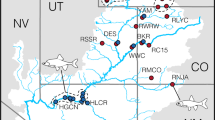Abstract
Within the species complex of Daphnia galeata,D. cucullata and D. hyalina variouscombinations of hybrids and parental taxa occur inlakes throughout Europe. Since daphnids are cyclicparthenogens and mostly reproduce asexually, hybridpopulations can be maintained by asexual reproductionand without recurrent hybridization events. Therefore,it is possible that hybridization events have beenrare, with range expansion occurring by dispersal ofhybrids.Allozyme data from seven European populations wereused to compare genetic variation within and betweenhybrid and parental taxa. An UPGMA cluster analysis ofgenetic distances showed that D. cucullata × galeatahybrids from different lakes grouped indifferent clusters according to the lake from whichthey were isolated, suggesting multiple hybridizationevents. Clonal diversity within hybrid taxa wascomparable to parental taxa. Furthermore, evidence wasfound for introgression of the Pgi-S allele fromD. cucullata to D. galeata in three lakes.These results indicate that multiple hybridizationevents within this species complex are likely, andthat hybrid taxa can reproduce sexually.
Similar content being viewed by others
References
Carvalho, G. R. & H. G. Wolf, 1989. Resting eggs of lake-Daphnia. I. Distribution, abundance and hatching of eggs collected from various depths in lake sediments. Freshwat. Biol. 22: 459–470.
Colbourne, J. K. & P. D. N. Hebert, 1996. The systematics of North-American Daphnia(crustacea, anomopoda)–a molecular phylogenetic approach. Phil. Trans. r. Soc. Lond. B 351: 349–360.
Flößner, D., 1993. Zur Kenntnis einiger Daphnia-Hybriden. Limnologica 23: 71–79.
Gießler, S., 1997. Analysis of reticulate relationships within the Daphnia longispinaspecies complex. Allozyme phenotype and morphology. J. Evol. Biol. 10: 87–105.
Hebert, P. D. N. & M. J. Beaton, 1989. Methodologies for allozyme analysis using cellulose acetate electrophoresis. Helena laboratories Beaumont, Texas, 32 pp.
Hebert, P. D. N. & T. L. Finston, 1996. A taxonomic reevaluation of North-American Daphnia(Crustacea, Cladocera). 2. Newspecies in the Daphnia-pulexgroup from the South-Central United-States and Mexico. Can. J. Zool. 74: 632–653.
Hebert, P. D. N., S. S. Schwartz & J. Hrbáček, 1989. Patterns of genotypic diversity in Czechoslovakian Daphnia. Heredity 62: 207–216.
Hebert, P. D. N. & C. C. Wilson, 1994. Provincialism in plankton: endemism and allopatric speciation in Australian Daphnia. Evolution 48: 1333–1349.
Hrbáček, J., 1987. Systematics and biogeography of Daphniaspecies in the northern temperate regions. In R. H. Peters & R. de Bernardi (eds), Daphnia, Pallanza, Mem. Inst. ital. Idrobiol. 45: 37–76.
Mayr, E., 1942. Systematics and the origin of species. Columbia University Press, New York, 332 pp.
Müller, J. & A. Seitz, 1995. Differences in genetic structure and ecological diversity between parental forms and hybrids in a Daphnia species complex. Hydrobiologia 307: 25–32.
Nei, M., 1978. Estimation of average heterozygosity and genetic distance from a small number of individuals. Genetics 89: 583–590.
Pielou, E. C., 1975. Ecological Diversity. Wiley-Interscience, New York, 165 pp.
Schwenk, K., 1997. Evolutionary genetics of Daphniaspecies complexes–hybridismin syntopy. Ph. D Thesis, University of Utrecht, The Netherlands, 141 pp.
Schwenk, K. & P. Spaak, 1995. Evolutionary and ecological consequences of interspecific hybridization in cladocerans. Experientia 51: 465–481.
Simpson, E. H., 1949. Measurement of diversity. Nature 163: 688.
Spaak, P., 1994. Genetical ecology of a coexisting Daphniahybrid species complex. Ph. D Thesis, University of Utrecht, TheNetherlands, 125 pp.
Spaak, P., 1995. Sexual reproduction in Daphnia: interspecific differences in a hybrid species complex. Oecologia 104: 501–507.
Spaak, P., 1996. Temporal changes in the genetic structure of the Daphniaspecies complex in Tjeukemeer, with evidence for backcrossing. Heredity 76: 539–548.
Spaak, P. & J. R. Hoekstra, 1993. Clonal structure of the Daphnia population in Lake Maarsseveen: its implications for diel vertical migration. Arch. Hydrobiol. Beih. Ergebn. Limnol. 39: 157–165.
Swofford, D. L. & R. B. Selander, 1981. BIOSYS-1: a fortran program for the comprehensive analysis of electrophoretic data in population genetics and systematics. J. Hered. 72: 281–283.
Taylor, D. J. & P. D. N. Hebert, 1992. Daphnia galeata mendotae as a cryptic species complex with interspecific hybrids. Limnol. Oceanogr. 37: 658–665.
Taylor, D. J. & P. D. N. Hebert, 1993. Habitat-dependent hybrid parentage and differential introgression between neighboringly sympatric Daphniaspecies. Proc. Natl. Acad. Sci. USA. 90: 7079–7083.
Weider, L. J. & H. B. Stich, 1992. Spatial and temporal heterogeneity of Daphniain Lake Constance; intra-and interspecific comparisons. Limnol. Oceanogr. 37: 1327–1334.
Wolf, H. G., 1987. Interspecific hybridization between Daphnia hyalina, D. galeataand D. cucullataand seasonal abundance of these species and their hybrids. Hydrobiologia 145: 213–217.
Wolf, H. G. & M. A. Mort, 1986. Interspecific hybridization underlies phenotypic variability in Daphniapopulations. Oecologia 68: 507–511.
Author information
Authors and Affiliations
Rights and permissions
About this article
Cite this article
Spaak, P. Hybridization in the Daphnia galeata complex: are hybrids locally produced?. Hydrobiologia 360, 127–133 (1997). https://doi.org/10.1023/A:1003157117667
Issue Date:
DOI: https://doi.org/10.1023/A:1003157117667




